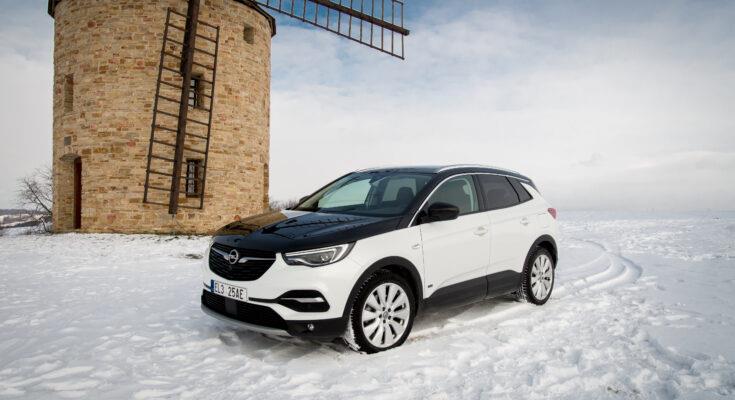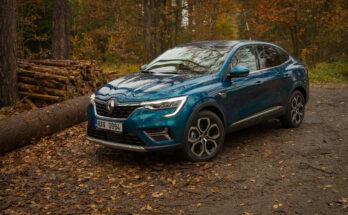When a colleague from the editorial office set out to take over the Ford Focus ST for a week's test, I was openly envious of him. A sporty hatchback with a turbocharged petrol engine, that's a dream after all. Instead, I earned an Opel Grandland X Hybrid4 – it was already clear from the name that it would be something big and a bit on batteries. But that thing has 300 horsepower…
What is Grandland anyway?
The Opel Grandland X is the first SUV of the Opel brand, produced under the control of the PSA concern. It practically shares the platform with the Peugeot 3008, but plays on a significantly more conservative note. You can indulge in the Grandland X either with a petrol or diesel engine (in both cases only with front-wheel drive) or as a plug-in hybrid. In that case, there is a choice between the Hybrid2 variant with front-wheel drive only or the Hybrid4 – analogously – with all-wheel drive.
In the tested car, the proven "six" with a power of 147 kW (200 hp) borrowed from Peugeot works under the front hood, in conjunction with an electric motor with a power of 81 kW. And since we are testing the Hybrid4 model, we mustn't forget the second 83kW electric motor located at the rear axle. The total effective output of this system is 221 kW – i.e. a magical 300 horses. On the road, this herd is transferred using an eight-speed automatic with paddle shifters under the steering wheel.
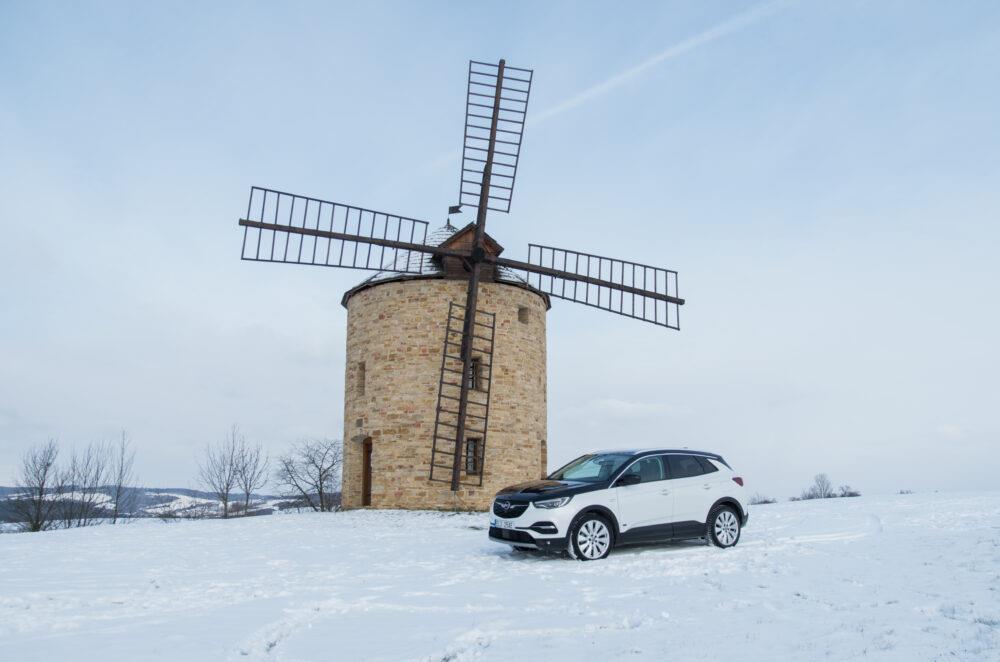
Dad with the peak backwards
At first glance, the Grandland X (doesn't) impress with its conservative design. Even the nineteen-inch rims do not look out of place considering the size of the car. Overall, the exterior appearance/proportions give the impression of a traditional and compact car, and Opel has far from embarked on such experiments as its sister Peugeot with its 3008. However, what catches your attention is the black-painted roof (actually including all pillars except for the roof) and the optional black-painted hood that breaks up the monotony of the pearly white. A bit extravagant? Yes. Maybe even slightly inappropriate. But together with the black cladding in the lower part of the body (mudguard edges, door bottoms, sills, lower part of the bumpers) it is an optically functional whole, and after a few days I got used to the contrasting black and white combination to the extent that I even started to like it .
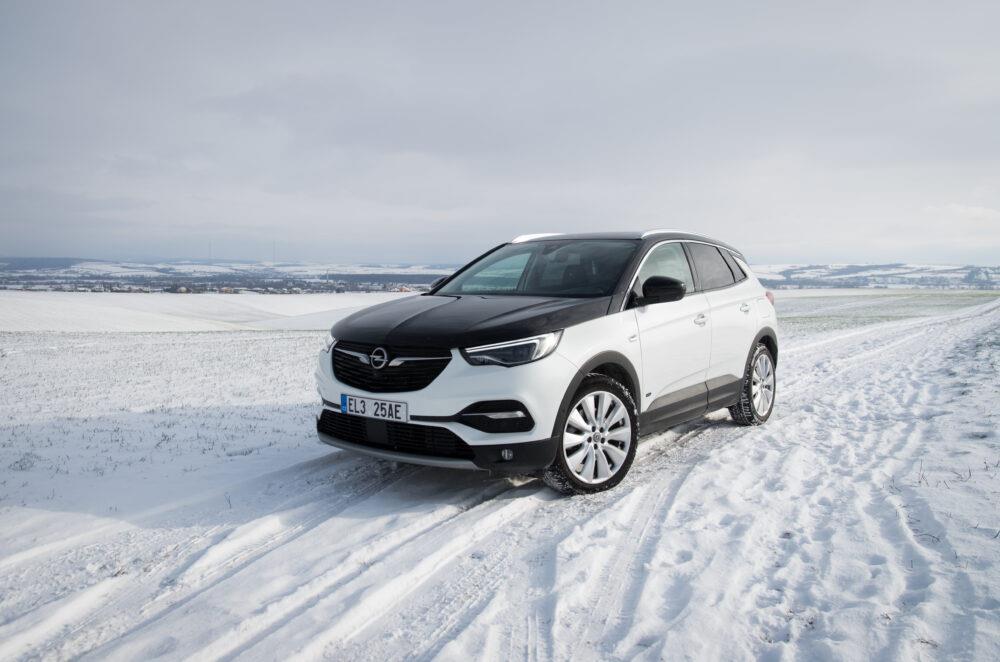
Like in the living room
In the interior, you will be embraced by seats upholstered in black leather – in the front with three-stage heating and ventilation, as well as very decent lateral guidance. The slower onset of heating (even at the highest level) should be compensated by the fact that not only the seat is heated, but also the lumbar area – which I must definitely praise. In the New Year's temperatures below zero, the absence of a heated steering wheel in the tested car froze – in this model year, however, Opel fixed it, and together with the leather seats, this convenience now goes hand in hand. The driver's seat is fully electrically adjustable (with memory) to find the optimal position behind the wheel. For the passenger, it is a combination with a classic manual shift. Of course, the multifunctional steering wheel is adjustable in height and length.
Opel sticks to tradition, without any fads, even on the instrument panel. Don't expect any displays, tablets or digital indicators. Two classic analog alarm clocks dominate here. A speedometer and a so-called "economy meter" – that is, a device that lets you know how economically you are currently driving. From blue recuperation (recovery of energy when decelerating), through green ecological driving (in hybrid mode it is driving purely on electricity) to the rest of the scale, towards the full performance of the entire active system. The instrument cluster is complemented by small indicators of the tank status and battery charge level, and below them the display of the on-board computer showing consumption, range and, possibly, energy flow.
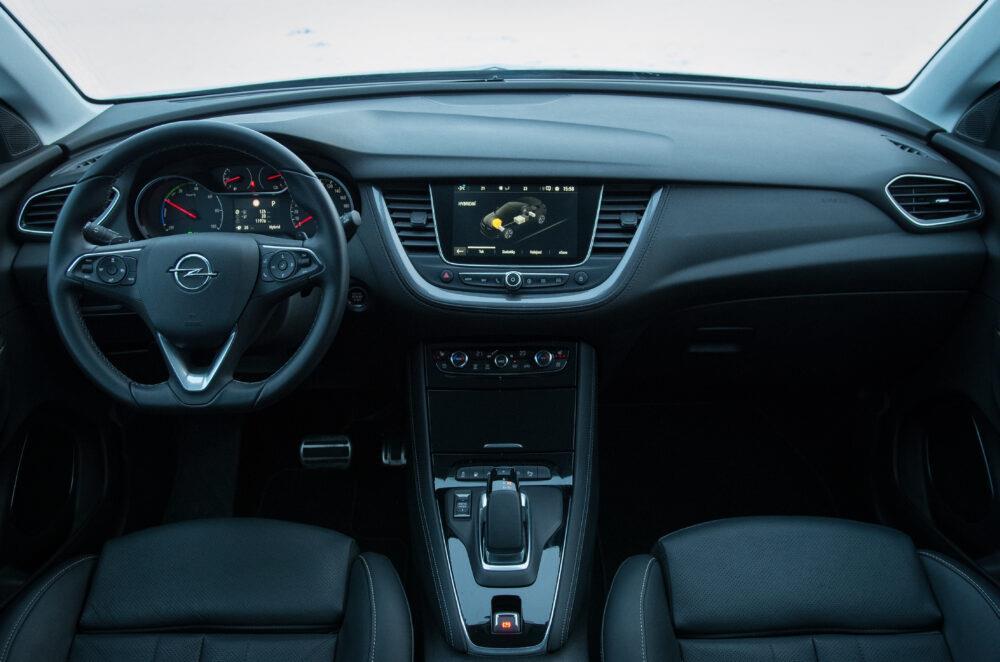
The central console is dominated by the infotainment display, which provides, in addition to the standard radio, navigation and settings of the vehicle itself, the possibility of smartphone integration in the form of Apple CarPlay or AndroidAuto. Very comfortable and very addictive. A little lower down is the control of the two-zone automatic air conditioning (for fine-tuning, for example, the direction of the blowing, it is necessary to use the touch screen). The drive mode selector of the eight-speed gearbox may be familiar to you from the already mentioned Peugeot 3008, as well as the drive system selector.
Grandland X offers a royal portion of interior space not only in the front, but also for rear passengers. Although the bench is not movable, there is still plenty of space even for taller passengers. With a four-seat occupancy, it offers an armrest in the middle; possibly a pass for skis. The luggage space might seem like a small negative – compared to the conventional gasoline variant, it loses more than a hundred liters of volume. However, the basic volume of 390 liters can be increased to more than 1,500 liters by folding down the rear seats. Detractors of hybrids would certainly immediately declare: "It's the batteries to blame!", but that's not the case. The batteries are rather placed under the rear seats. The fact that it is a car with all-wheel drive has cut its portion of the luggage volume. As I already mentioned, you simply can't get it in Grandland X in combination with a conventional gasoline/diesel engine. The quad bike is therefore only available in the plug-in hybrid version.

How to transfer all that power to the road?
Grandland X offers four driving modes – Electro, Hybrid, Sport and 4WD.
In the case of the Electro mode, it is, as the name suggests, pure electric operation. With a fully charged 13.2kWh battery, you can travel more than 50km in this mode at a speed of up to approx. 135km/h. The reality of course depends on the route profile and driving style. Related to this is the necessary question: "Where to get the electricity?". There are several options. By charging from public fast chargers, you are "full" in less than two hours. From the home network (if you don't have a "wallbox"), you will have to wait about 8 hours for the maximum recharge – ideally plug it in the garage overnight and go to work in the morning with practically no carbon footprint. Therefore, with the right profile of the route, distance, temperature and star constellation, consumption can be practically zero.
I would dare to mark the Hybrid mode (especially for longer trips) as the default. Transitions between individual drive types are practically imperceptible and the internal combustion engine only makes itself known under higher load. Sound insulation is exemplary. Then, when you are completely drained, for example during a long trip, the Grandland X functions as a mild-hybrid. It recharges during braking/descending and can then handle the restart calmly and purely electrically. A quiet district consumption will then fit into seven liters with a reserve. At a faster highway pace, you have to take into account the mass that needs to be moved and the aerodynamic resistance that needs to be overcome – then the almost two-ton SUV can claim to consume nine liters of gasoline per hundred kilometers. If you accept short-term higher consumption, the eSave function can also be attractive, when you practically only use the internal combustion engine, which, in addition to driving the car, also serves as an electrical energy generator. It recharges your battery while you drive – you can choose whether up to an electric range of 10km, 20km or "to full". However, it is redeemed by the consumption attacking 14 liters.

But when will you not regret burning gasoline like this? You're going. You can't keep up. You don't have time to charge. But at the same time you know that your favorite district is waiting for you in a few tens of kilometers. So you switch to eSave and, with increased consumption, you generate energy for storage. And why? After all, you should switch to Sport mode with the first tight corner and let the Grandland X fully develop the entire 300 horses that the hybrid system offers. After pressing the pedal to the floor, a kickdown follows calmly by four gears, after which the Opel bites into the asphalt with all four wheels and starts forward. After six seconds, the speedometer needle already attacks one hundred and the rush of power does not stop even at significantly higher speeds. But in corners, the Opel will remind you that you are driving an SUV. The center of gravity is high, you have to brake early, and the lateral seat guidance also has its limits. No, it's not a sports car – you can't even expect that from a car in this category. Nevertheless, the chassis feels sure, and yet not harsh, even on roads with a worse surface. The car does not oversteer in any way, and the mentioned 300 horsepower not only gives you a more nimble ride, but also a power reserve for safer overtaking.
The last drive mode is 4WD. In a way, one could talk about an electronic lock, but there is nothing to close… Thanks to the possibility of purely electric drive of both axles, the 4WD mode will allow you to move in the terrain practically with a step. Whether it's descending or climbing – there's no need to worry about the ideal speed, because the electric motor offers enough torque almost immediately. It works precisely even on snow-covered hills and in sudden steep climbs – even off-road, so Opel pleasantly surprised.
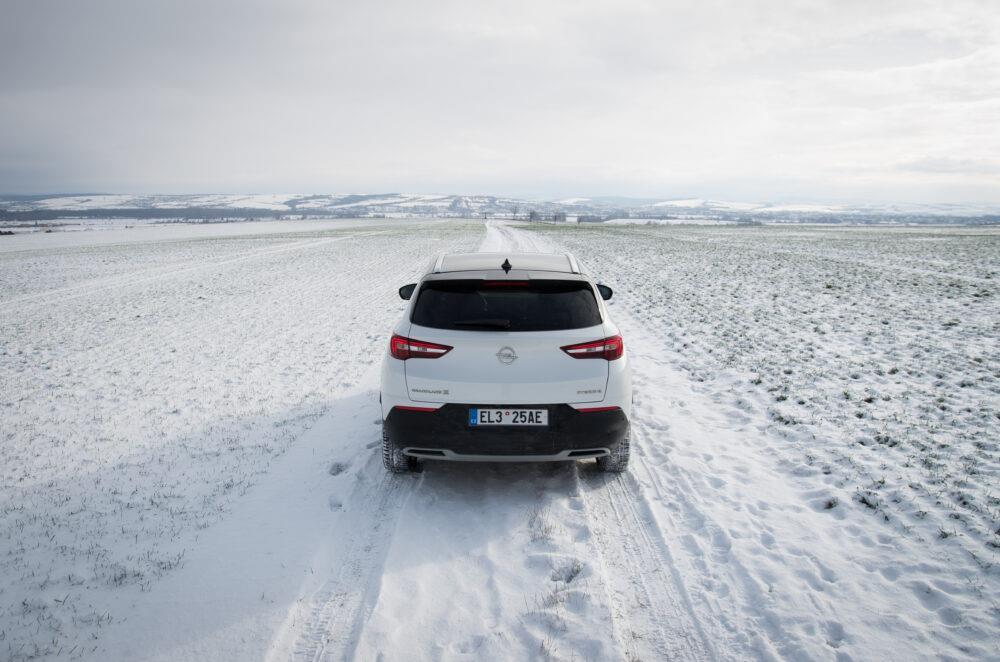
Do you want me?
Overall, the Opel Grandland X Hybrid4 is a great choice for fans of modern technology who don't want to draw too much attention to themselves and prefer inconspicuousness to extravagance. You won't be afraid of unpaved roads near the city either, and due to the extensive interior equipment, all-wheel drive and plug-in hybrid system, the price tag starts at 1.2 mil. CZK justified.
Photo: Author

